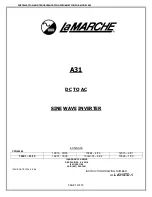
7
-4
Motor
Overheat
1
Motor Overheating Alarm
The
Inverter will stop or will continue
to
operate according to the setting of
L1-03.
The
motor has overheated.
Check
the size of the load and the
length
of the acceleration, deceler-
ation,
and cycle times.
Check
the V/f characteristics.
Check
the motor temperature
input
on terminals A1 and A2.
Motor
Overheat
2
Motor Overheating Fault
The
Inverter will stop according to the
setting
of L1-04.
The
motor has overheated.
Check
the size of the load and the
length
of the acceleration, deceler-
ation,
and cycle times.
Check
the V/f characteristics.
Check
the motor temperature
input
on terminals A1 and A2.
DynBrk
Resistor
Installed Braking Resistor Over-
heating
The
braking resistor is overheated and
the
protection function has operated if
it
has been enabled in L8-01.
The
deceleration time is too short and
the
regenerative energy from the
motor
is too large.
• Reduce
the load, increase the
deceleration
time, or reduce the
motor
speed.
• Change
to a Braking Resistor
Unit.
DynBrk
Transistr
Internal Braking Transistor Fault
The
braking transistor is not operating
properly.
-
• Try
turning the power supply
off
and on.
• Replace
the Inverter if the fault
continues
to occur.
Motor
Overloaded
Motor Overload
The
motor overload protection func-
tion
has operated based on the internal
electronic
thermal value.
The
load is too heavy. The accelera-
tion
time, deceleration time, and cycle
time
are too short.
Check
the size of the load and the
length
of the acceleration, deceler-
ation,
and cycle times.
The
V/f characteristics voltage is too
high
or too low.
Check
the V/f characteristics.
The
Motor Rated Current (E2-01) is
incorrect.
Check
the Motor Rated Current
(E2-01).
Inv
Over-
loaded
Inverter Overload
The
Inverter overload protection func-
tion
has operated based on the internal
electronic
thermal value.
The
load is too heavy. The accelera-
tion
time, deceleration time and cycle
time
are too short.
Check
the size of the load and the
length
of the acceleration, deceler-
ation,
and cycle times.
The
V/f characteristics voltage is too
high
or too low.
Check
the V/f characteristics.
The
Inverter capacity is too low.
Replace
the Inverter with one that
has
a larger capacity.
Over-
torque
Det
1
Overtorque Detected 1
There
has been a current greater than
the
setting in L6-02 for longer than the
setting
in L6-03.
-
• Make
sure that the settings in
L6-02
and L6-03 are appropri-
ate.
• Check
the mechanical system
and
correct the cause of the
overtorque.
Over-
torque
Det
2
Overtorque Detected 2
There
has been a current greater than
the
setting in L6-05 for longer than the
setting
in L6-06.
-
• Make
sure that the current set-
ting
in L6-05 and time setting in
L6-06
are appropriate.
• Check
the mechanical system
and
correct the cause of the
overtorque.
Table 7.1 Fault Displays and Processing (Continued)
Display
Meaning
Probable Causes
Corrective Actions
Summary of Contents for SYSDRIVE 3G3RV
Page 1: ...USER S MANUAL SYSDRIVE 3G3RV High function General purpose Inverters Cat No I532 E1 1...
Page 36: ...1 22...
Page 106: ...3 14...
Page 126: ...4 20...
Page 216: ...5 90...
Page 388: ...7 26...
















































